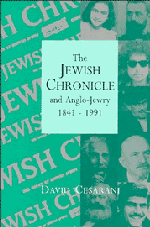Book contents
- Frontmatter
- Contents
- Preface
- Acknowledgements
- Introduction
- 1 Origins and pioneers, 1841–1855
- 2 Defining an identity: the Jewish Chronicle and mid-Victorian Anglo-Jewry, 1855–1878
- 3 The era of Asher Myers and Israel Davis, 1878–1906
- 4 The hegemony of Leopold Greenberg, 1907–1931
- 5 Discordant interlude: J. M. Rich and Mortimer Epstein, 1932–1936
- 6 Ivan Greenberg and the crisis years, 1937–1946
- 7 The post-war era: J. M. Shaftesley and David Kessler, 1946–1958
- 8 The Jewish Chronicle under William Frankel, 1958–1977
- 9 The Jewish press in a divided community: Geoffrey Paul, 1977–1990
- Conclusion
- Notes
- Bibliography
- Index
- Plate section
5 - Discordant interlude: J. M. Rich and Mortimer Epstein, 1932–1936
Published online by Cambridge University Press: 22 September 2009
- Frontmatter
- Contents
- Preface
- Acknowledgements
- Introduction
- 1 Origins and pioneers, 1841–1855
- 2 Defining an identity: the Jewish Chronicle and mid-Victorian Anglo-Jewry, 1855–1878
- 3 The era of Asher Myers and Israel Davis, 1878–1906
- 4 The hegemony of Leopold Greenberg, 1907–1931
- 5 Discordant interlude: J. M. Rich and Mortimer Epstein, 1932–1936
- 6 Ivan Greenberg and the crisis years, 1937–1946
- 7 The post-war era: J. M. Shaftesley and David Kessler, 1946–1958
- 8 The Jewish Chronicle under William Frankel, 1958–1977
- 9 The Jewish press in a divided community: Geoffrey Paul, 1977–1990
- Conclusion
- Notes
- Bibliography
- Index
- Plate section
Summary
Leopold Greenberg's death precipitated a long period of strife within the management of the Jewish Chronicle. As long as he had been controlling editor the other directors had, perforce, to leave the direction of policy in his hands. In any case, there was a large measure of harmony between the original members of the group which purchased the paper in 1907. Leopold Kessler, Jacobus Kann and Joseph Cowen sat on the Board of Directors throughout this period. Israel Davis was chairman of the Board until his death in 1927, when he was succeeded by Cowen. However, Greenberg's death, followed by that of Cowen in May 1932, upset the equilibrium. Internal discord coincided with years of turmoil in Anglo-Jewry as it faced the challenge of Nazism in Germany, the influx of refugees from central Europe, Fascism at home and a renewed crisis in Palestine.
During the months before he died Greenberg was too ill to edit the paper. His son Ivan, who had been appointed assistant editor in 1925, deputised for him. Ivan anticipated that the editorial chair would be his by succession and was certain that his father intended this to happen. However, Dr Mortimer Epstein, the paper's managing director, told Ivan on the day after his father's death that he was not going to become editor. Instead, Epstein arranged for the position to go to Jack M. Rich, the secretary of the Board of Deputies.
- Type
- Chapter
- Information
- The Jewish Chronicle and Anglo-Jewry, 1841–1991 , pp. 142 - 157Publisher: Cambridge University PressPrint publication year: 1994

